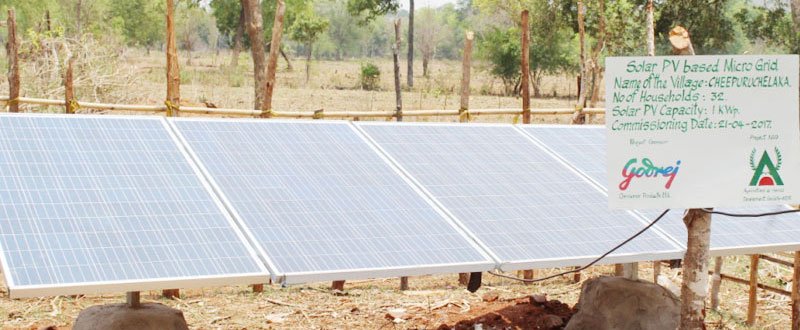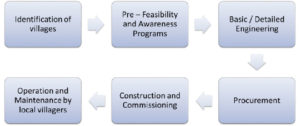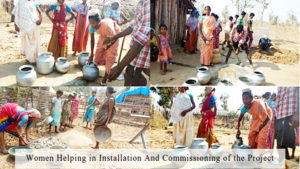
GCPL SOLAR POWER ELECTRIFICATION
DEVELOPMENT OF “SOLAR PV BASED MICRO GRIDS ” IN ANDHRA PRADESH ( VILLAGE ELECTRIFICATION ) FINAL REPORT
1. EXECUTIVE SUMMERY
Agricultural and Social Development Society (ASDS) is implementing the Village Electrification projects by developing Solar PV based micro grids in East and West Godavari Districts of Andhra Pradesh. The project is developed under Corporate Social Responsibility (CSR) scheme of Godrej Consumer Products Limited (GCPL). In the first phase, first phase 18 numbers of villages covering 460 households were electrified. The detailed list of villages and the projects is discussed in the next chapters. A total of 22 kWp was installed in the first phase, the last system was commissioned in Pusugumpuvillage on 7 May 2017.
2. INTRODUCTION
The Ministry of New and Renewable Energy (MNRE) aims to attain a sustainable growth in the country by securing the energy needs through Renewable Energy (RE) sources such as Solar, Wind, Biomass, Hydro etc. Along with the support to large scale RE generators, the Ministry also promotes the Decentralized Energy Generation solutions based on sources such as Solar, Wind, Biomass, Hydro etc for meeting the Electrical and Thermal energy requirements especially in rural areas.
Renewable Energy in India:
India has set an ambitious target of reaching 175 GW of installed capacity from renewable energy sources including 100 GW from solar and 60 GW from wind by the year 2022. Various policy initiatives have been taken to achieve this target.
Solar and wind power being infirm in nature impose certain challenges on grid security and stability. Studies revealed that solar and winds are almost complementary to each other and hybridization of two technologies would help in minimizing the variability apart from optimally utilizing the infrastructure including land and transmission system.
3. SOLAR
India, with its large population and rapidly growing economy, needs access to clean, cheap and reliable sources of energy. India lies in the high solar insolation region, endowed with huge solar energy potential with most of the country having about 300 days of sunshine per year with annual mean daily global solar radiation in the range of 4 – 7 kWh/m2/day. Solar power can also help meet energy requirements for both grid connected as well as off-grid applications such as solar powered agricultural pump sets.

4. PRESENT SCENARIO
Agriculture and Social Development Society (ASDS) is actively working in developmental activities in East and West Godavari districts of Andhra Pradesh State, India. ASDS identified 25 villages for electrification in the first phase. In the first phase 460 houses were electrified in 18 villages. At present, the identified villages do not have any electricity supply. The main source of revenue to the villagers is by way of daily labour to nearby towns. The identified villages do not have any educational institutions, community centres, etc. The villagers walk for at least 3 kms for purchasing any grocery items etc. The villagers return back to their houses and complete their daily activities before sunset. Some of the households lit the houses with kerosene lamps while most of the houses cannot afford. There is a good potential for installation of micro grids and electrify the villages.
5. MICRO GRID
A ‘Micro Grid’ system is similar to a mini grid but having a RE based generation capacity of below 10 kW. Micro and mini gridsgenerally operate in isolation to the electricity networks of the DISCOM grid (standalone), but can also interconnect with the grid to exchange power. If connected to grid they are termed as grid connected mini/ micro grid.
6. ROAD MAP
PROJECT DEVELOPMENT PROCESS
The team of experienced people will be working on Renewable Energy based projects from conception to commissioning. The systematic approach will enable for reliable project development in this specialized market with maximum involvement in decision making by the stakeholders.


For any project, it is proposed to follow the following procedure for development of the project. The following phases, carefully concluded at the end of each phase with the Owner, Operator and Stakeholders:
| S No | Activity | Description |
| 1 | Pre – Feasibility | A top-Line Evaluation of the possibilities, requirements and objectives for a specific site. The pre-feasibility includes financial cost and revenue estimation and is intended as a bases for strategic decision making. |
| 2 | Awareness programs | Conduct Awareness programs and Training Programs about the proposed projects |
| 3 | Basic Engineering | During basic engineering, final technical decisions are made and the documentation for procurement is generated |
| 4 | Detailed Engineering / Design | All engineering documentation, Layout drawings, Electrical schemes, Civil and Structural drawings, instructions in ‘good for construction’ status |
| 5 | Procurement | Procurement of all the Equipment as per Bill of Material (BOM) |
| 6 | Construction | To carry out the supervision of construction activity and quality of the works as per the standards |
| 7 | Commissioning and Start up | Commissioning and operation of wide range of Power Projects |
7. EMPLOYMENT GENERATION
Installation and commissioning of micro grids generates the employment both for unskilled and skilled labour. The unskilled people can be used for Mechanical and Civil works such as erection of module mounting structures, solar modules, civil foundation, etc. During the construction of the micro grids, local villagers were employed.
Three people were shortlisted at the district level for providing the rigorous training on the installation and commissioning, O&M of the Solar PV based micro grids. The trained professions will be responsible for carrying out the maintenance and also train the youth. The trained youth on Solar PV micro grids can get placed in Solar PV power plants in India and abroad.
8. SKILL SET REQUIRED AND CHALLENGES
Installation of renewable energy power project is a step in the right direction, it poses few challenges and at the same time provides a plethora of opportunities. One of the major challenges is to meet the growing need for skilled manpower, both in terms of quality and quantity.
Some of the key issues related to manpower are:
Availability of adequate skilled manpower
The sector is facing challenges in sourcing skilled manpower in many functional areas like manufacturing, production, installation, operation & maintenance, marketing and research & development. As the sector is relatively new and fast growing, there is a shortage of experienced or skilled manpower. It is also important to note that the renewable energy sector is more manpower-intensive than the conventional energy sector.
Attracting talent
There is a general lack of awareness amongst the student community on the challenging career and entrepreneurial opportunities that exist in this sector. There is an opportunity to attract students, enthusiastic young entrepreneurs, and experienced professions in this sector.
Training and capacity building
The installation, operation and maintenance of renewable energy systems need specific skills and knowledge. To impart this skill and knowledge to those entering the sector as well as continuously upgrading them, there is a need for training and capacity building. Currently there is a shortage of renewable energy trainers or training centres, who can offer this service to the industry. Also, there is a need to setup institutional mechanisms to offer intensive and comprehensive training in all aspects of renewable energy.
9. COMMUNITY OWERNERSHIP
Apart from creating improved access to electricity, the plan is to generate a sense of ownership to the project from the community by ensuring their participation from the very beginning. This enables long term ownership of the system and hence its sustainability. Essentially the idea is that each household contributes a certain amount per month as decided by the Gram Sabhas to contribute towards basic maintenance of the system even though in practise this might pose as a challenge particularly with regards to regularity in contribution.
It is in this context, that we propose a metering system along with the solar system (at least one per village, which is not considered at this stage) so that the community can be made aware of their consumption patterns and accordingly be willing to make corresponding contribution towards maintenance.
In addition, in the long term the government’s policy on net metering (when installed) policy may facilitate the community to augment their contribution towards maintenance of the solar project by contributing to grid electricity.
WOMEN SUPPORT :
In the first phase, the local villages cooperated in installation and commissioning of the projects at different villages. Women of the local villages actively supported in Civil and Mechanical works while installation of the project. The involvement of women during the project construction phase shows the need of electricity for the villages.


– COMMUNITY ORGANIZATION AND EXPOSURE
Since the community is quite unaware of the efficacy of such a solar system, capacity building programs with the community before and after the installation is imperative. Several meetings were organized with representatives of the villages that will receive power from the project.
The initial attempt was to explain how the Solar system works and will power the village along with its limitations. One person from each village was identified to create awareness about the solar powered systems. Eventually we envisage informal committees in each village to emerge to carry out the responsibilities related to running and maintaining the system.
– OPERATIONAL COMMITTEE
Youth normally come forward to learn how to run the system. One youth from each village invited to take responsibility to ensure collections every month and take care of basic issues that may arise in the electricity distribution. The youth will also be responsible for training the fellow villagers. The idea is that he is given basic training in the precautions necessary to run the system and take care of minor repair issues. Additionally, when there is a major problem they could get in touch with implementing agency and seek consultation from qualified engineers to make the necessary repairs.
LOCATION
Vyavasayaka Mariyu Sanghika Abhivrudhi Samstha
(Agricultural and Social Development Society - ASDS)
Rekhapally, V R Puram Mandal
East Godavari (Dist) - 533 349
Andhra Pradesh - India
E-mail : gandhibabuasds@yahoo.co.in
asds_rkp@rediffmail.com
Phones: +91 8106270717, +91 9440537588
DONATE NOW
Click on the Donation Button to Donate and Support ASDS to reach more and needier Tribal and Marginalised People. Thank you:
